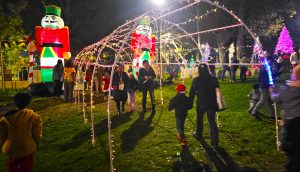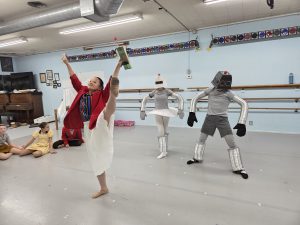Jacques Ropert looked a little old to be playing in the mud in the middle of Santa Clara University’s Forge Garden, but he did seem to be enjoying himself. Not wanting to miss out on the ageless fun, Katharine Rondthaler Krieg, Garden Manager, took off her shoes and joined him.
They looked like they were pressing grapes with their feet to make wine—except that it was mud.
They were using their feet to mix straw into a pile of sifted, sandy sub-soil mixed with water. This cob mixture would be used to add a mud plaster finish to a curved garden bench made of cob. The bench is 30 inches high and long enough to seat five people comfortably or seven squished. That’s a lot of mud. A lot of cob.
Cob is similar to adobe but uses a higher percentage of straw, which adds strength, and is applied by hand in large globs rather than by pre-formed bricks. Although cob is an inexpensive building material, cob construction is labor intensive.
It took about 15 Forge Garden volunteers two days, working about five hours each day, to make the cob and then shape it (by hand like pottery) into a bench. Everything needed was sourced on site.
The bench was built above the soil on a base of discarded pavement chunks from a sidewalk on campus that was being removed. After drying, the bench was ready for its final mud plaster. As a decorative finishing touch, abalone shells were pressed into the cob. The last step will be a coating of white, lime plaster to add color and water proofing.
“Primitive technology using natural materials is resurfacing,” said Ropert, a San Mateo resident who volunteers at Forge Garden. “I’m doing this to share this natural building concept with people. It’s fun to do, even alone, but it’s better as a community-based project.”
Just as they were in ages past around the world, cob houses are still built in California. They are strong and earthquake resistant enough to meet building codes. The California soil is good for cob because it already has sand in it.
“Most of the soil in California is perfect,” said Ropert.
[wp-anything-slider setting=’SETTING2′]
Heading north from Santa Clara on Interstate 280, is a large cob house on the right (east) side, overlooking Crystal Springs Reservoir. Known as “the Flintstones House,” the Hillsborough landmark home sold for $2.8 million last.
Ropert, born in Paris, said that cob building is very popular in northern California. In particular, the tiny town of Hopland (in Mendocino County) is considered “the Mecca of natural building.”
“The more you dig into cob, the more you discover its magic,” said Ropert. “You realize it’s an amazing product. Mud science is very beautiful; the molecular part of mud is amazing.”
“When you do this, you forget time,” said Ropert, still prancing around in the mud with Rondthaler Kreig.
The half-acre edible, organic Forge Garden, 1051 Sherman St. at Benton St., was established in 2008 on the site of an old forge from the late 1800s that once served Santa Clara University.
“We are excited to get to use our cob bench and work on other natural building projects around the garden,” said Rondthaler Krieg. “Next up is a cob pizza oven during the Winter 2018 quarter.”
Find out more about the garden, volunteer opportunities, free classes and the Friday Forge Farm Stand at www.facilities.scu.edu/sustainability/programs/theforge/.












0 comments